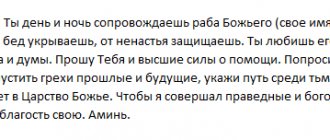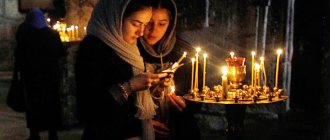How prayer and meditation affect the functioning of the human brain
Specialists from the laboratory of psychophysiology of the St. Petersburg Institute named after. Bekhterev at the end of the last century conducted a global study of the influence of prayer on brain function. The experiment, led by Doctor of Biological Sciences Valery Slezin, involved people belonging to various faiths. Experiments have shown that during deep prayer there is a kind of shutdown of the cerebral cortex. At the same time, the person was fully conscious.
When recording the electrical activity of the brain (electroencephalogram data), it looks like this: during moments of wakefulness, the cerebral cortex of an adult generates alpha (a state of complete relaxation of both the body and consciousness) and beta rhythms (a state of active wakefulness) rhythms with a frequency of, respectively, 8 to 13 and 14 to 40 Hz.
Immersion in a state of deep prayer led to a slowdown in brain rhythm to a frequency of 3 Hz. The preserved biopotentials had such a small amplitude that they practically approached a straight line.
These slow rhythms are called delta rhythms. In an adult, they are recorded in an unconscious state (state of deep sleep or coma). And in a state of wakefulness they are observed only in infants up to three to four months.
Scientists were faced with a paradox: the encephalogram of the praying person’s brain (regardless of what religion he belonged to) corresponded to the state of a coma or a newborn child. I can’t help but remember “Be like children...”.
By the way, similar states of brain rhythms are also characteristic of people immersed in certain types of meditation.
In addition, during prayer and meditation, a person’s oxygen consumption noticeably decreases - by about 20%, while during sleep - by only 8%. It turns out that prayer and meditation restore the functioning of the brain and the whole body even better than sleep.
The practices of prayer and meditation lead to synchronization of the brain hemispheres. It is known that usually one of the brain hemispheres dominates the other. This determines a person’s propensity for figurative (intuitive) or logical (analytical) thinking. As a result of practice over a period of time from 2–4 weeks to several months, the “weak” hemisphere is pulled up and reaches the level of the leading one, and the electrical rhythms of both hemispheres are synchronized. This makes a person more energetic, protected, creative - i.e. healthy in every sense (physical, emotional and intellectual).
To be continued
“God, where are you?” Psychophysiology of prayer
Today we are interested in the purely medical aspects of this widespread religious phenomenon - scientific facts or, at least, reliable statistics.
Prayer and Statistics
The first fairly solid scientific study was carried out by the American cardiologist Bird in the 80s of the last century. A so-called “intercessory prayer” was organized for 392 patients in the cardiac intensive care unit of a San Francisco hospital.
The patients were divided into two equal groups. Patients from the first group were prayed for daily by parishioners of local Protestant and Catholic churches, and the second group was a control group - they did not pray for it. The prayer continued until the patients were discharged from the clinic, while none of the 392 patients knew whether they were praying for him or not, which excluded the effect of self-suggestion.
And here are statistically significant results: 12 patients in the control group required artificial ventilation. In the “prayer” group, the patients’ lungs were in much better condition, and no one had to be connected to a ventilator.
Diuretics, usually used to treat congestive heart failure, were needed in 15 patients in the control group and in 5 cases in the “prayer” group. Cardiac arrest occurred in 14 cases among the control group and only in 3 cases in the “prayer” group.
It must be said that Dr. Byrd's research made a strong impression on the American public. Previously, approximately 14% of friends and relatives prayed for their loved ones, but by 2011 this figure increased to 49%.
But still, the best effect is obtained when a person prays himself. Back in 1982, Dr. Gardner discovered that among believers who regularly practice prayer, the incidence of cancer of various locations is significantly lower.
Don't get me wrong, I'm not advocating TREATING cancer with prayer. There is even a saying about this: “Cancer is hopelessness at the cellular level”... But what is stopping us from including prayer as a component of cancer prevention?
By the way, some Russian women who practice deep prayer immersions talked about spontaneous cures of gynecological diseases. But so far these data have not been subjected to proper statistical processing.
Physiology of prayer
Dr. Andrew Newberg of Thomas Jefferson University has been studying the brains of people involved in various spiritual practices for about 20 years. Newberg himself is an atheist, which gives his work great credibility. Using functional computed tomography to observe people praying, the scientist discovered foci of activity in the frontal lobes in areas responsible for attention, behavioral modulation, and linguistic expressiveness. This concerned prayer and meditative states of the middle level.
When the depth of prayer increased (and this happened in more experienced participants), the activity of the frontal lobes decreased, but foci of excitation appeared in the thalamus - in the structures that regulate the flow of sensory information to many parts of the brain. Simply put, these people stopped seeing, hearing and feeling pain and touch.
Coming out of a state of prayer, they talked about the feeling of losing time and space, about the feeling of merging with the entire Universe. And this is the absolute truth, since computed tomography recorded at these moments a sharp decrease in the activity of the parietal lobes, in the areas responsible for the three-dimensional perception of objects in space.
Scientists also noted that during deep prayerful states, the neural pathways of the frontal and parietal lobes of the brain, which are also responsible for sexual arousal, are involved. Now it becomes clear the expression of orgasm on the face of the blessed one in Bernini’s composition “The Ecstasy of Saint Teresa” and in the paintings of many artists who captured similar moments.
It is interesting that the Orthodox style of prayer, unlike the Catholic one, is characterized by a complete absence of paroxysms on the EEG, and therefore does not imply orgasmic reactions. The fact is that although Orthodox prayer can also be deep, its mechanism works to SUPPRESS emotions and, accordingly, there is no surge in neurotransmitters and hormones.
Professor Slesin from the Bekhterev Psychoneurological Institute also established that deep prayerful immersion is a psychophysiological state completely different from the trance states of the so-called “psychics.” During Orthodox prayer, the effect of suppressing cortical dominance is observed, but there is no interhemispheric asymmetry and paroxysmal manifestations that “psychics” are guilty of.
I believe that dopamine, which is released during ecstatic states, plays a large role in the healing process. But other neurophysiological mechanisms are likely also involved.
There are situations in which prayer does not work. For example, medical studies have not revealed cases of the positive effect of prayer in alcoholism and drug addiction. Do you think the relatives of these people don’t pray? How they pray! Yes, it’s all to no avail - this is shown by the results of many reviews. My humble opinion on this matter: “God will not help people who do not want to change their lives. He respects even idiotic choices.”
My prayer experience
I once saw the classes of a small Protestant group meeting in the evenings in an ordinary high school, where I rented a hall for karate classes. Despite all the primitiveness of these guys, the impression was created that they had direct access to the Almighty. And when I felt bad (and during the period of work in the cardiac intensive care ambulance team, this often happened), I would go straight to these Protestant prayer services in a white robe and ask for prayerful support.
I must say, there was never any refusal. They instantly stopped the sermons, stood in a circle and began to pray for me. After 10 minutes, with renewed vigor, I got into the yellow ambulance and went to fulfill my medical duty.
I did not become a member of that small Protestant community, since a good science education did not allow me to intellectually accept the virgin birth and the walk on water. However, I believed unconditionally in the possibility of contact with the Almighty as a special wise force. I prayed for myself and for many near and far. The main thing here is the sincerity of the request to God.
And on duty, I once met the linguist professor K. A. Timofeev. The professor suffered from paroxysmal atrial fibrillation, which I was able to successfully treat with novocainamide. As a reward, Kirill Alekseevich taught me ancient Greek, which allowed me to read the New Testament in the original and fully appreciate the art of prayer.
When in my prayer processes I got tired of pouring out complaints, I suddenly discovered that in the depths of my soul a feeling of awe appeared - as when contemplating something beautiful. As a rule, depression, anxiety, and depression also went away. I think that magnetic resonance imaging could not have been done here - the tonsils of the brain were probably glowing with the proper light and the healing process from potential diseases was in full swing.
Sergey Bogolepov
Photo thinkstockphotos.com
Reasons for absent-mindedness in prayer
- A careless attitude towards prayer . We focus on what is important to us. What we think about in prayer is the idol that obscures God.
- Lack of clarity of the text . It occurs due to the incomprehensibility of the Church Slavonic language and the incomprehensibility of the images used in prayers.
- Impact of fallen spirits . One of the desert monks said: “When the devil sees that we are praying and trying to completely devote ourselves to prayer, he tries in every possible way to distract our attention. He is very resourceful and cunning and, to achieve his insidious goals, uses those thoughts, themes and experiences that especially bother us. He hits us in especially sensitive, weak places, gives rise to vicious thoughts, inflames them in our minds in every possible way... By those thoughts that usually come to us during prayer, we can recognize our weak points, the passions operating within us, and we must fight them direct our efforts."
- Disproportion rules to spiritual forces. Prayer books usually publish a complete prayer rule intended for monks and spiritually experienced lay people. However, for those who are just beginning to follow the prayer rule, it is difficult to immediately begin to read it in its entirety. Typically, confessors advise starting with several prayers, and then, every one or two weeks, adding one prayer to the rule, so that the skill of reading the entire rule is developed gradually and naturally.
- Weakness of will . It requires education, training of will, and daily effort. Studying the experience of ascetics can help with this.
- Psychological factors: fatigue, absent-mindedness - inability to concentrate the mind for a long time.
In order to get enough sleep, it is recommended to go to bed on a different day than when you need to get up.
Components of mindful prayer
Attentive prayer is a gift from God to those who are diligent in acquiring it. Prayer is given to the one who prays.
Our prayer reflects our inner state. It is necessary to avoid over-concern, clogging the memory and imagination with unnecessary information - the main enemy of prayer in the modern world.
Factors that contribute to concentration are also need, interest, and the right attitude.
The Need for Attention in Prayer
Absent-mindedness during prayer very clearly testifies to our isolation from God. Can we imagine the absent-mindedness when meeting with the head of state, the patriarch, or a famous person?
Prayer is a personal request, not a reading of a text. God knew this text before we were born.
If we do not listen to ourselves, during prayer, thinking about vanity, then why do we expect that God will listen to us? Inattentive prayer is hypocrisy before God: “This people honors Me with their lips, but their heart is far from Me” (Mark 7:6).
Chapter 13. TEMPTATIONS FROM DEMONS DURING PRAYER
Now we should talk about measures to combat these temptations. The main means, according to the teachings of the holy fathers, in this case is prayer. “During such temptations,” says St. Neil of Sinai, “constantly use short but intense prayer.”800. How strong the prayer of a believer is and what effect it has on demons can be seen from the comparison of Saint Elijah Ekdik, who says that “he who threatens dogs with a stick irritates them against himself, and the demons are irritated by the one who forces (forces - “Igum.V.”) himself pray purely”801.
But, before starting such a prayer, it is useful and necessary to say a few words against the spirit of malice tempting the one praying. Saint Evagrius teaches: “During temptations, do not begin to pray until you have spoken a few angry words against the tempter. For when the soul is qualified (filled - “Igum.V.”) with bad thoughts, then its prayer cannot be pure. But if you say anything with anger against them, then you will confuse your opponents and destroy their suggestions.”802
The Rev. Nikita Stifat points out exactly what words should be pronounced in such cases. Speaking about blasphemous thoughts - one of the types of temptations - he explains that “the spirit of blasphemy, when we pray and sing psalms, sometimes, due to our inattention, belches out with our lips oaths against us and strange blasphemies against the Most High God, bringing them into verses of psalms and words of prayer. But against him, when he utters something like that with our lips or puts something into our thoughts, we must turn the word of Christ, saying to him: “Get behind me, Satan” (Matthew 4:10), filled with every stench and condemned to eternal fire; let your blasphemy fall on your head.” Having said this, we will immediately forcefully, like a prisoner, turn our minds to some other object - Divine or human, whatever comes to mind, or with tears we will lift it up to heaven and to God.”803.
Since the temptations of the evil one, leading to a state of delusion, are not always in a rough and noticeable form, the holy ascetics give a number of instructions on how to distinguish between the phenomena of delusion and grace, which from the outside can sometimes resemble one another, especially in the eyes of someone inexperienced in this. human affairs.
St. Maxim Kavsokalivit, comparing grace and charm, speaks in the sense that the distinctive sign of grace is a special state of spiritual peace with tenderness and contrition for sins. A person is filled with meekness and humility, and his soul is enveloped in spiritual joy. “When the grace of the Holy Spirit enters a person,” he says, “it gathers his mind and makes him attentive and humble, brings to his memory death and his sins, future Judgment and eternal torment, fills his soul with contrite tenderness and subjects him to tears and tears, makes his eyes meek and full of tears, and the closer he gets to a person, the more he pacifies his soul and consoles him with the holy sufferings of our Lord Jesus Christ and His boundless love for mankind, and fills his mind with sublime contemplations of the unimaginable power of God... Then the human mind is delighted with the Divine. light and is enlightened by the light of Divine knowledge, the heart becomes quiet and meek and abundantly exudes the fruits of the Holy Spirit - “joy, peace, long-suffering, kindness, mercy, love, humility” (Gal. 5:22) and so on, and his soul receives indescribable joy "804.
On the contrary, when a person has fallen under the influence of the tempter and is in a state of delusion, then his sensations will be different, opposite to those indicated. At first, a subtle vanity appears, which then turns into pride. Such a person lacks humility and peace of mind. “When the evil spirit of delusion,” says the Monk Maxim, “approaches a person, it disturbs his mind and makes him wild, hardens and darkens his heart, instills fear, fear, and pride, perverts his eyes, disturbs his brain, makes his whole body tremble, ghostly before the eyes it shows a light that is not bright and pure, but reddish... and forces the lips to speak obscene and blasphemous words; the one who sees this spirit of delusion is mostly angry and filled with anger, does not know humility at all, nor true crying and tears, but always boasts of his good things and is vain about them, when, without restraint and fear of God, he succumbs to the movements of passions, and finally comes out of mind and comes to complete destruction”805.
So, a person in a state of delusion is, first of all, deprived of peace of mind and true tenderness - these sure signs of a grace-filled state of spirit. In addition, it lacks three basic virtues: humility, love and mercy, “without which no one will see the Lord”806.
Pure prayer, without delusion, according to St. Gregory of Sinaite, will be one during which “the mind is seen as formless and does not represent itself or anyone else even for a moment, being distracted from the feelings by the light acting in it. For then the mind becomes detached from everything material and luminous, inexpressibly uniting into one spirit with God.”807.
As Saint Hesychius says, this happens due to the fact that “every thought reproduces in the mind the image of some sensual object, for the Assyrian (enemy), being himself a mental power, can only seduce by using something sensual that is familiar to us... And since every thought enters the heart through the imagination of something sensory (the sensory interferes with the mental), the Divine light of the Divine begins to illuminate the mind when it is abolished from everything and becomes completely formless (representing no form or image). For this lordship manifests itself in a mind that is already pure, under the condition that it is impoverished from all thoughts.”808.
During such prayer, the intellect seems to freeze or, as Saint Maximus Kavsokalivit says, “the mind remains inactive and obeys only the Holy Spirit”809 and, “dying in the action of the most perfect prayer, it is rejected from all worldly thoughts”810.
Therefore, in the life of the Monk Barsanuphius, compiled by Nicodemus Agiorite811, which reports on the admiration for God that the monk received in prayer, it is emphasized that he ascended to God “not on the dreamy wings of thought, but in the ineffable power of the Spirit, believing in ascension to God in your heart"812.
In accordance with this, throughout the entire “Philokalia” there is no mention anywhere of the development of mental, brain, energy, since this is not only unnecessary, but extremely harmful and even dangerous for the person praying, for it leads to pride and fall. The entire center of gravity lies in the development of the feelings of the heart, because in spiritual prayer, pure from all ideas and imaginations, the intellectual side does not play a role.
Does prayer help others heal?
Ambiguous research results may encourage further study of the problem
A new study on the relationship between prayer and heart disease has raised many questions for scientists that they are unable to answer at the moment.
The study didn't find much benefit from prayer. But that's probably not the end of the story.
"It's the first step, but it's not the be-all and end-all," says researcher Dr. Mitch Krukoff.
"We're still early in our scientific understanding of how much prayer influences healing," he says.
Krukoff is a professor of medicine at Duke University Medical Center. He is also responsible for medical devices for the treatment of cardiovascular diseases at the Duke Clinic Research Institute. The results of the study were published in The Lancet.
The Effect of Prayer
748 people took part in the study. They had to undergo a surgical procedure on the heart - a cardiac catheterization - to check the blocked artery. 3 of the 4 also had other procedures to widen these arteries.
The researchers asked a large number of congregations of different faiths around the world to pray for 371 patients. Another 377 patients were not included in the official list of those for whom they would pray.
Each patient received standard medical care. Some people have also used various types of therapy, such as music therapy, imagery therapy, and touch therapy. The patients were followed for 6 months.
All groups had similar results in the study's main endpoints: a composite of heart problems, readmission within 6 months, or death.
But other parameters showed some benefits.
Possible benefits
Although prayer did not produce positive results in a broad sense, Krukoff said there were improvements in some specific areas.
Emotional distress before surgery and mortality rates 6 months after the procedure were lower in the group that received music, tactile, and imagery therapy
“These are probably the oldest healing traditions in the world, but we evaluate them against modern methods of therapy,” says Krukoff.
“This science sets the stage for us to continue to explore until we finally understand the role of the human spirit in the context of high-tech cardiovascular care,” he says.
Different methods
The study involved Buddhist, Muslim, Jewish and Christian congregations around the world.
The patients' names were sent to congregations 30 minutes after they were assigned to the group of people being prayed for.
Congregations could pray for patients wherever and however they wanted. Some prayed for 5 days, some for as long as 30 days.
“We specifically involved different religious denominations that were physically in different time zones, who said prayers with different syntax, over different periods of time,” says Krukoff.
“The extent, timing and duration of prayer depended on the daily practices of different congregations. We didn't dictate terms,” he says.
Some groups might say, “So be it.” Others may have asked that the procedure go well and doctors not make a mistake, Krukoff says.
“They were prayed for as much as possible,” he says.
Patients (their friends, relatives or acquaintances) could also pray outside the study.
Double Prayer
In last year's study, a second group of congregations was asked to pray for congregations that were praying for patients.
"This dual therapy had an impact on 6-month readmissions and death, which means it may have a different effect than praying for an individual patient," Krukoff says. This discovery requires further investigation.
Placebo effect?
The patients were not told which group they were in, the people being prayed for or not being prayed for?
They were asked which group they thought they were in? Two-thirds of those who were not prayed for thought that they were prayed for.
This belief of theirs could have influenced the results. Krukoff and his colleagues will study this possibility in the future.
“To me, this is one of the most interesting things about our data,” he says. “We have many unique descriptions and observations that will help us understand these data to better conduct research in the future.”
There are still many questions left
"We don't know the actual mechanism at all," Krukoff says.
For example, he says, “No one knows whether it is better to pray for 30 days or 5 days. Or which religious rite should be preferred?
"What's surprising is that every congregation has a limited schedule of prayers for sick people," Krukoff says. Prayers can be said once a week, once a month, or twice a day—once alone and once at vespers with the entire congregation, Krukoff says.
It is unknown whether prayers said before the end of the procedure had any effect.
Can science understand prayer?
"There are certain limitations, and there's nothing wrong with that," says Dr. Keith Gee. Midor
Meador was not involved in the study. He is Professor of Pastoral Theology in Medicine at Duke Divinity School. Meador is also a clinical professor of psychiatry for empirical research at Duke Medical School, Meador says.
"But I'm skeptical about attempts to measure prayer and study it using the standard empirical methods that modern researchers use," he says.
According to Meador, the definition of prayer and the methods of study are important.
"These findings should inform those of us who work at the intersection of spirituality, religion and health about the complexities of this work," he says.
“This should not in any way affect a believer, his understanding of prayer,” says Meador.









